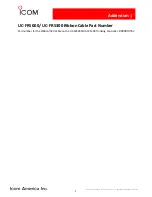
v1.1
UM-R8XDLIM-HY-01
Page 31
Dual Band ICS Repeater User Manual
So,
DL Gain = Min {(DL Total Output Power
– 8dB – Input Power), Maximum DL Gain}
Example:
For WCDMA Repeater: Suppose DL Total Output Power = 37dBm; DL Gain = 95dB;
Rxpower = -55dBm; G
Ant
=
8dBi; L = 3dB;
Input Power = -55dBm + 8dBi
– 3dB = -50dBm
So, DL Total Output Power - Input Power
– 10dB =37dBm –(-50dBm)– 10dB = 77dB
Hence, DL Gain = Min {(DL Total Output Power
– Input Power– 10dB), Maximum DL Gain}
= Min (77dB, 95dB)=77dB
4.2.1.2 UL Gain Value
Taking into account uplink noise floor and gain balance issue between uplink and downlink in the
repeater system, it is recommended the uplink gain be set 5dB lower than the downlink gain.
If repeater is close to the Node B/eNode B, there will be high input power at the BTS port,
interference may exist even when the attenuation has reached its maximum value. It is
recommended to add an RF attenuator at repeater’s BTS port to avoid interference to the Node
B/eNode B.
4.2.1.3 Isolation
Refer to section 3.2 to obtain the isolation value and ensure the isolation condition meet:
As defined above, UL Gain = DL Gain
– 5dB, so the equation can be changed to be:
Sufficient Isolation
DL gain is set to be the calculated value in section 4.2.1.1 and UL Gain = DL gain
– 5dB
Insufficient Isolation
Adjust or move the antennas to increase isolation value. If isolation cannot be increased,
re-adjust the DL gain as the figure below:
Example:
UL Gain = DL Gain – 5dB
Isolation ≥ (DL Gain of Re 15dB) – 30dB
Isolation ≥ (UL Gain of Re 20dB) – 30dB
Isolation ≥ (DL Gain of Repeater– 15dB)
UL Gain = DL Gain – 5dB
















































